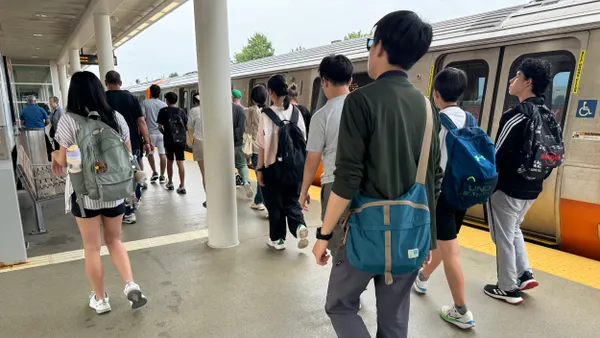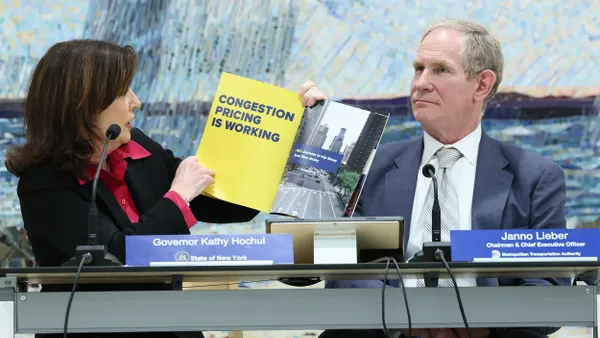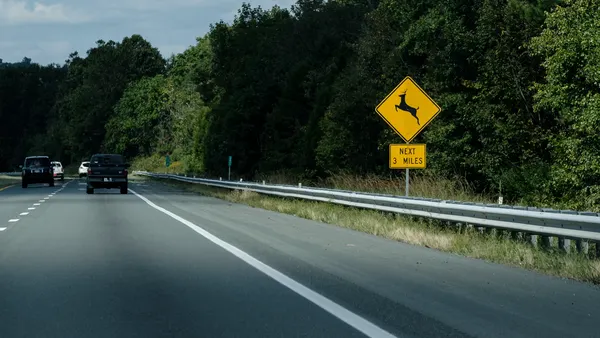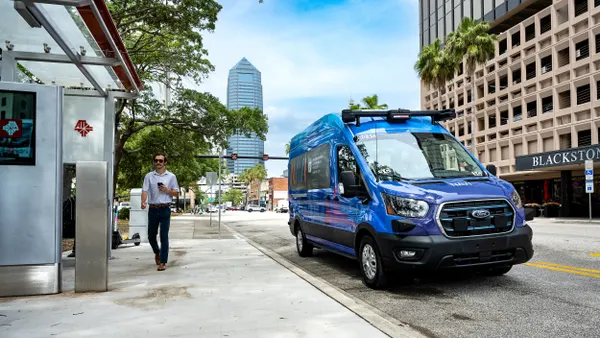Mobility is at the heart of making future city development smarter. If all parts of a city aren't connected by transportation infrastructure — either public or private — then the residents of that city aren't able to utilize city services or access all the opportunities that a city provides. Investing in transportation can also improve public safety, either by removing drivers from the roads with investment in public transportation, or by investing in self-driving cars, making the roads safer as autonomous vehicle (AV) improves.
Nat Parker is the CEO of moovel North America, a company that developed an app where users can search for, book and pay for rides all in one spot. Depending on the city, the app connects to different services, like Lyft, Uber, bike-sharing or public transport routes. Smart Cities Dive spoke with Parker to get a sense of where the future of mobility and smart transportation may be headed.
The following interview has been edited for brevity and clarity.
Smart Cities Dive: How do you compare mobility issues in the U.S. to European cities?
NAT PARKER: I think there are more similarities than there are differences, from a geographic perspective, in so far as increasing urbanization, serious congestion issues and infrastructure meeting its natural limit in terms of carrying capacity on the road. I think there are similar issues with consumer desire for options other than single-occupancy vehicles. The largest place that we see differences is that U.S. cities are highly designed to be car-centric. Many older European cities are much more pedestrian driven. Secondly, from a public policy and regulatory standpoint, the U.S. has a much more flexible attitude and set of policies that enable alternative business models, such as ride-sharing and ride-for-hire or transportation networking companies. And when it comes to promoting the use of AV technology, currently the U.S. is really fostering an environment for that kind of innovation, whereas in the European Union, this is much more tightly controlled, at least currently.
Where do you think we are in the U.S., especially in the city space, in terms of moving toward smart mobility?
PARKER: When it comes to the core of infrastructure, and in particular public transportation, I would say that we're reaching a tipping point where further investment and further upgrades in technology, in terms of carrying capacity, is going to be required, because of the influx of people moving to urban areas. We're not talking about building more lanes on the highways. You either have to look at congestion pricing or you have to invest in the public transportation network, and other modes that get people out of the single-occupancy vehicle.
When it comes to car-sharing, this is a market that's a bit more mature today. This is a business that is increasing in popularity, increasing in usage. I think you'll see car-sharing continue to play an important role, especially with the introduction of AV in the market.
When it comes to urban mobility, what should we be looking at for the next five to 10 years?
PARKER: The role of cities themselves will be absolutely paramount to this concept of urban mobility. The day-to-day commute is specific enough to each city in which someone lives that we need relevant local solutions. I think cities themselves, their public transit networks and their partners and alternative ride providers, are in a very good position to offer people efficient mobility options. Cities play the regulatory role, they can enable private partnerships and they will also provide much of the physical infrastructure for vehicles to pull up to a curbside.
"[Self-driving cars are] going to change the day-to-day experience. It's going to free up people's days to have even more precious time, and I think that will be pretty important."

Nat Parker
CEO, moovel North America
We'll also need to see cities invest in the type of physical infrastructure required for electrical charging, for station-based vehicle charging. As fleets transform from internal combustion engines to fully electric vehicles, this is going to require a sea change of investment to support that.
So how big a deal are fully autonomous vehicles going to be?
PARKER: If there's any issue that could be debated, perhaps it's timing. I think many automakers, and tech giants for that matter, are making certain promises about delivery, and time-frames, those are the types of things that I think can be challenged. The technology itself is evolving extremely rapidly. The data does not point us in any other direction than growth in this technology. It's consistent, it's reliable and I think it's going to really change safety, it's going to change the day-to-day experience. It's going to free up people's days to have even more precious time, and I think that will be pretty important.
Do you think you could predict when it will become a widespread mode of transportation in cities?
PARKER: I think by the first half of the next decade it will be common to see at least limited deployments of AV. When it's widespread, fully adopted, I'll let you speculate further there. I think it's very fair to say that, in the first half of the next decade, you'll travel to many cities across the U.S. and see this service offer.
There's been some concern lately that focusing on ride-sharing, car-sharing and autonomous vehicles, without weight on public transportation, might create even more urban sprawl. What do you make of those concerns?
PARKER: I think some of those concerns are legitimate. The thinking goes, if you don't have to pay attention in your commute, and your commute takes one hour, but, during that hour you're able to connect to video conferencing with your colleagues, or you're able to chat with friends and essentially enjoy the ride in an autonomous vehicle, might you be more comfortable living at the periphery of the city than in the urban core? I think that's something that public policy makers should take seriously. I think there is some risk to that. However, I think that the investment in infrastructure required to support these future vehicles will naturally tend toward the network effects gained by building closely within an urban core.









